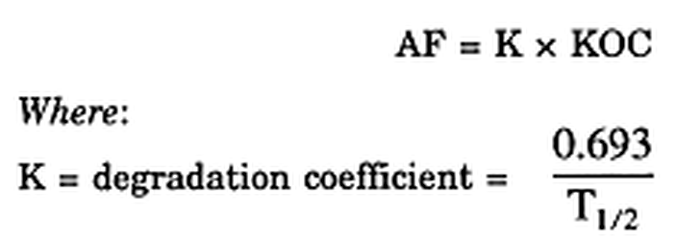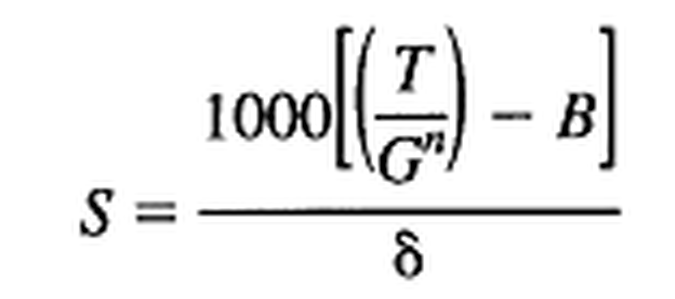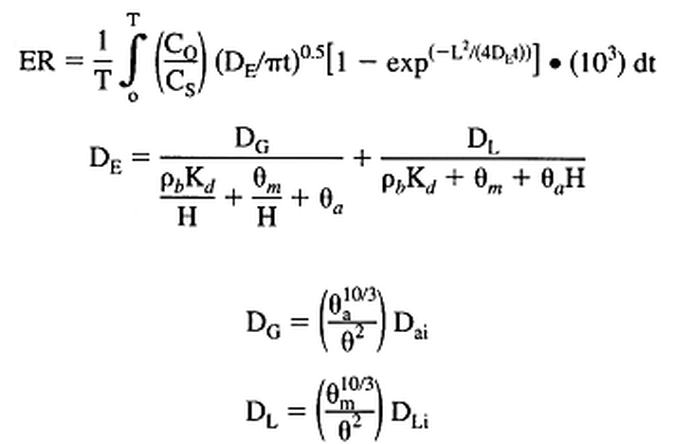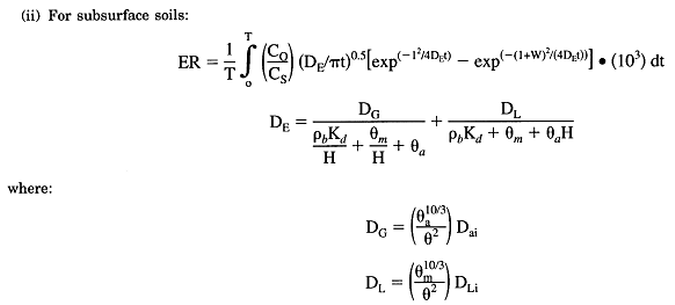[27 Pa.B. 4181]
[Continued from previous Web Page] § 250.304. MSCs for groundwater.
(a) A person shall implement a remedy under the Statewide health standard that is protective of human health and the environment.
(b) The MSCs for regulated substances in groundwater are presented in Appendix A, Tables 1 and 2. The methodology used by the Department for calculating MSCs in groundwater is detailed in subsections (c)--(f).
(c) The MSCs for regulated substances contained in groundwater in aquifers used or currently planned to be used for drinking water or for agricultural purposes is the MCL as established by the Department or the EPA (U. S. EPA, 1996. Drinking Water Regulations and Health Advisories. Office of Water. EPA 822-R-96-001). For a regulated substance where no MCL has been established, the MSC is the lifetime health advisory level (HAL) for that compound. For a regulated substance where neither an MCL nor a lifetime HAL is established, the MSC is the lowest concentration calculated using the appropriate residential and nonresidential exposure assumptions and the equations in §§ 250.306 and 250.307 (relating to ingestion numeric values; and inhalation numeric values).
(d) For regulated substances contained in aquifers not used or currently planned to be used, the MSCs in Appendix A, Tables 1 and 2 are calculated by the following:
(1) For volatile organic regulated substances with an attenuation factor of less than 20, as calculated by the methodology in paragraph (7), ten times the appropriate residential or nonresidential MSC for groundwater in aquifers used or currently planned to be used containing less than 2,500 mg/l total dissolved solids.
(2) For volatile organic regulated substances with an attenuation factor of greater than or equal to 20, as calculated by the methodology in paragraph (7), 100 times the appropriate residential or nonresidential MSC for groundwater in aquifers used or currently planned to be used containing less than 2,500 mg/l total dissolved solids.
(3) For semivolatile organic and inorganic regulated substances, regardless of the attenuation factor, 1,000 times the appropriate residential or nonresidential MSC for groundwater in aquifers used or currently planned to be used containing less than 2,500 mg/l total dissolved solids.
(4) For benzene, 100 times the appropriate residential or nonresidential MSC for groundwater in aquifers used or currently planned to be used containing less than 2,500 mg/l total dissolved solids.
(5) For regulated substances with no calculated attenuation factor because of a lack of data in Howard, P. H., R. S. Boethling, W. F. Jarais, W. M. Meylan and E. M. Michalenko. 1991. Handbook of Environmental Degradation Rates. Lewis Publishers, Inc., Chelsea, MI., the appropriate residential or nonresidential MSC for groundwater in aquifers used or currently planned to be used containing less than 2,500 mg/l total dissolved solids.
(6) For minimum threshold MSCs, 5 micrograms per liter in groundwater shall be used.
(7) The attenuation factor (AF) for an organic regulated substance shall be calculated according to the following formula:

T1/2--half-life of organic regulated substance in groundwater as reported in Howard, P. H., R. S. Boethling, W. F. Jarais, W. M. Meylan and E. M. Michalenko, 1991. Handbook of Environmental Degradation Rates. Lewis Publishers, Inc., Chelsea, MI.
KOC--organic carbon partitioning coefficient (See Appendix A Table 5)
(e) If the groundwater in aquifers used or currently planned for use at the site has naturally occurring background total dissolved solids concentrations greater than 2,500 milligrams per liter, the Statewide health standard for a regulated substance dissolved in the groundwater may be adjusted by multiplying the MSC for groundwater in aquifers by 100. The adjusted Statewide health standard shall then be used in calculating the soil to groundwater pathway numeric value as specified in § 250.308 (relating to soil to groundwater pathway numeric values).
(f) In addition to the requirements in this section, the MSCs are further limited by solubility as identified in Appendix A, Table 5. The solubility limits are derived from the following references, which are keyed to the numbers in Table 5:
(1) Howard, P. H. 1991. Handbook of Environmental Fate and Exposure Data for Organic Chemicals. Vol. III. Pesticides. Lewis Publishers.
(2) Lyman, W. J., W. F. Reehl, and D. H. Rosenblatt. 1982. Handbook of Chemical Property Estimation Methods. McGraw-Hill Book Co. NY.
(3) Mabey, et al. 1982. Aquatic Fate Process Data for Organic Priority Pollutants. SRI. EPA Contract Nos. 68-01-3867, 68-03-2981.
(4) Milne, G.W.A., Ed. 1995. CRC Handbook of Pesticides. CRC Press, Inc.
(5) Montgomery, J. H. 1991. Groundwater Chemicals Desk Reference. Vol. II. Lewis Publishers.
(6) Montgomery, J. H., and L. M. Welkom. 1990. Groundwater Chemicals Desk Reference. Vol. 1. Lewis Publishers.
(7) Montgomery, J. H. 1993. Agrochemicals Desk Reference, Environmental Data. Lewis Publishers.
(8) National Library of Medicine (Grateful Med). Hazardous Substances Databank.
(9) Nirmalakhandan, N. N., and R. E. Speece. 1988a. Prediction of Aqueous Solubility of Organic Chemicals Based on Molecular Structure. ES&T 22:328-337.
(10) Nirmalakhandan, N. N., and R. E. Speece. 1988b. Prediction of Aqueous Solubility of Organic Chemicals Based on Molecular Structure. 2. Application to PNAS, PCBs, PCDDs, etc. ES&T. 23:708-713.
(11) Sax, N. I. 1989. Dangerous Properties of Industrial Materials. Seventh Edition. Vol. 1-3. Van Nostrand Reinhold.
(12) Environmental Protection Agency. Undated. IRIS--The Integrated Risk Information System.
(13) Environmental Protection Agency. 1985. Physical/Chemical Properties and Characterization of RCRA Wastes According to Volatility. Office of Air Quality and Planning and Standards. EA 450/3-85-007.
(14) Environmental Protection Agency. 1989. Database of Chemical Properties for SARA. Section 313 Chemicals.
(15) Environmental Protection Agency. 1992. Handbook of RCRA Ground-water Monitoring Constituents: Chemical & Physical Properties. 40 CFR Part 264, Appendix IX. Office of Solid Waste. Permits and State Programs Division. EPA 530-R-92-022.
(16) EPA. 1994. Superfund Chemical Data Matrix. Office of Solid Waste and Emergency Response. EPA 540-R-94-009.
(17) Verschueren, K. 1977. Handbook of Environmental Data on Organic Chemicals. Van Nostrand Reinhold.
(18) Windholz. M., ED. 1976. The Merck Index. 9th ED. Merck and Co.
§ 250.305. MSCs for soil.
(a) A person shall implement a remedy under the Statewide health standard that is protective of human health and the environment.
(b) The MSCs for regulated substances in soil are presented in Appendix A, Tables 3 and 4. The methodology for calculating MSCs in soil is detailed in subsections (c)--(e) and the MSCs are further limited to not exceed the physical capacity of the soil to contain a regulated substance. This physical limitation is based on an assumed porosity of 0.35, an assumed dry bulk density of soil of 1.8 kilograms per liter and an assumed density of a regulated substance of 1.0 kilograms per liter. This is calculated according to the equation in paragraph (1). For regulated substances which are organics and liquids at standard temperature and pressure (STP) as identified in Appendix A, Table 5 (Chemical Properties), the physical limitation is further limited based on residual saturation with the additional assumption of a residual saturation ratio of substance volume to soil volume of 0.051, as calculated in Equation (2).

where:
|grrs = density of the regulated substance = 1.0 kg/L
n = porosity of the soil = 0.35
|grB = dry bulk density of the soil = 1.8 kg/L
Sr = residual saturation ratio (substance vol./soil vol.) = 0.051(c) For the residential standard, the MSC for regulated substances contained in soil is one of the following:
(1) The lowest of the following:
(i) The ingestion numeric value throughout the soil column to a depth of up to 15 feet from the existing ground surface as determined by the methodology in § 250.306 (relating to ingestion numeric values), using the appropriate default residential exposure assumptions contained in § 250.306(e).
(ii) The inhalation numeric value throughout the soil column to a depth of up to 15 feet in soil from the existing ground surface, which considers volatilization into the outdoor air and inhalation of particulates, as determined by the methodology in § 250.307 (relating to inhalation numeric values), using the appropriate default residential exposure assumptions contained in § 250.307(d).
(iii) The soil-to-groundwater pathway numeric value throughout the entire soil column as determined by the methodology in § 250.308 (relating to soil to groundwater pathway numeric values).
(2) The lowest of paragraph (1)(i) and (ii) and, in addition, one of the following:
(i) A demonstration of the soil-to-groundwater pathway soil buffer as identified in § 250.308(b), if applicable.
(ii) A soil-to-groundwater pathway equivalency demonstration as identified in § 250.308(d).
(d) For the nonresidential standard, the MSC for regulated substances contained in soil throughout the soil column to a depth of 2 feet from the existing ground surface is one of the following:
(1) The lowest of the following:
(i) The ingestion numeric value as determined by the methodology in § 250.306, using the appropriate default nonresidential exposure assumptions contained in § 250.306(e).
(ii) The inhalation numeric value which is the lower of the values for volatilization into the outdoor air and the inhalation of particulates, as determined by the methodology in § 250.307, using the appropriate default nonresidential exposure assumptions contained in § 250.307(d).
(iii) The soil-to-groundwater pathway numeric value throughout the entire soil column as determined by the methodology in § 250.308.
(2) The lowest of paragraph (1)(i) or (ii) and, in addition, one of the following:
(i) A demonstration of the soil-to-groundwater pathway soil buffer as identified in § 250.308(b), if applicable.
(ii) A soil-to-groundwater pathway equivalency demonstration as identified in § 250.308(d).
(e) For the nonresidential standard, the MSC for regulated substances contained in soils at depths greater than 2 feet through 15 feet from the existing ground surface, is one of the following:
(1) The lowest of the following:
(i) The inhalation numeric value which considers volatilization to the outdoor air, as determined by the methodology in § 250.307, using the appropriate default nonresidential exposure assumptions contained in § 250.307(d), and using a transfer factor (TF) based upon the calculated emission rate from subsurface soil as specified in the method of Jury, et al. 1990. Water Resources Research, Vol. 26, No. 1, pp. 13--20.
(ii) The soil-to-groundwater pathway numeric value throughout the entire soil column as determined by the methodology in § 250.308.
(2) The value identified in paragraph (1)(i) and one of the following:
(i) A demonstration of the soil-to-groundwater pathway soil buffer as identified in § 250.308(b), if applicable.
(ii) A soil-to-groundwater pathway equivalency demonstration as identified in § 250.308(d).
(f) The MSC for regulated substances contained in soil at depths greater than 15 feet is one of the following:
(i) The soil-to-groundwater pathway numeric value as determined by § 250.308(a).
(ii) A demonstration of the soil-to-groundwater pathway soil buffer as identified in § 250.308(b), if applicable.
(iii) A soil-to-groundwater pathway equivalency demonstration as identified in § 250.308(d).
(g) A person conducting a remediation of soils contaminated with a substance having a secondary MCL will not be required to comply with the soil-to-groundwater pathway requirements for those substances to protect groundwater in aquifers for drinking water.
§ 250.306. Ingestion numeric values.
(a) For a regulated substance which is a systemic toxicant, the ingestion numeric value for that substance was calculated using the appropriate residential or nonresidential exposure assumptions from subsection (d) according to the following equation:

(b) For a regulated substance which is a carcinogen, the ingestion numeric value for that substance was calculated using the appropriate residential or nonresidential exposure assumptions from subsection (d) according to the following equation:

(c) For a regulated substance that has both an oral reference dose and an oral cancer slope factor, the ingestion numeric value is the lower of the two numbers as calculated by the equations in subsections (a) and (b).
(d) The default exposure assumptions used to calculate the ingestion numeric values are as follows:
Term Residential Nonresidential (Onsite Worker) Systemic1 Carcinogens2 THQ Target Hazard Quotient 1 N/A 1 RfDo Oral Reference Dose (mg/kg-day) Chemical-specific N/A Chemical-specific BW Body Weight (kg)
Soil
Groundwater
15
70N/A
70
70ATDC Averaging Time for systemic toxicants (yr)
Soil
Groundwater
6
30
N/A
N/A
25
25Abs Absorption (unitless)3 1 1 1 EF5 Exposure Frequency (d/yr)
Soil
Groundwater
250
350
250
350
180
250ED Exposure Duration (yr)
Soil
Groundwater
6
30
N/A
N/A
25
25IngR Ingestion Rate
Soil (mg/day)
GW (L/day)
100
2
N/A
N/A
50
1CF Conversion Factor
Soil (kg/mg)
GW (unitless)
1 x 10-6
1
1 x 10-6
1
1 x 10-6
1TR Target Risk N/A 1 x 10-5 1 x 10-5 CSFo Oral Cancer Slope Factor (mg/kg-day)-1 N/A Chemical-specific Chemical-specific Atc Averaging Time for carcinogens (yr) N/A 70 70 Ifadj4 Ingestion Factor
Soil (mg-yr/kg-day)
GW (L-yr/kg-day)N/A
57.1
1.1
17.9
0.4Notes:
1Residential exposure to noncarcinogens is based on childhood (ages 1-6) exposure for soil, and adult exposure for groundwater, consistent with USEPA (1991).
2Residential exposure to carcinogens is based on combined childhood and adult exposure.
3The oral absorption factor takes into account absorption and bioavailability. In cases where the oral RfD or CSF is based on administered oral dose, the absorption factor would be limited to bioavailability. The default value is 1.
4The Ingestion Factor for the residential scenario is calculated using the equation Ifadj = EDc × IRc/BWc + EDa × IRa/Bwa, where EDc = 6 yr, IRc = 100 mg/day for soils and 1 L/day for groundwater, BWc = 15 kg, EDa = 24 yr, IRa = 50 mg/day for soils and 2 L/day for groundwater, and BWa = 70 kg. The ingestion factor for the nonresidential scenario is calculated using the equation Ifadj = ED × IR/BW, where ED = 25 yr, IR = 50 mg/day for soils and 1 L/day for groundwater, and BW = 70 kg.
5In cases where the inhalation RfD or CSF is based on absorbed dose, this factor can be applied in the exposure algorithm. The default value is 1.(e) The residential ingestion numeric value for lead in soil was developed using the Uptake Biokinetic (UBK) Model for Lead (version 0.4) developed by the EPA (U. S. Environmental Protection Agency. (1990). Uptake Biokinetic (UBK) Model for Lead (version 0.4). U. S. EPA/ECAO. August 1990, in lieu of the algorithms presented in subsections (a) and (b). Default input values are identified in Appendix A, Table 7. Because the UBK model is applicable only to children, the nonresidential ingestion numeric value was calculated according to the method developed by the Society for Environmental Geochemistry and Health (Wixson, B. G. (1991)). The Society for Environmental Geochemistry and Health (SEGH) Task Force Approach to the Assessment of Lead in Soil. Trace Substances in Environmental Health. (11-20), using the following equations:

Table 7 identifies each of the variables in this equation.
§ 250.307. Inhalation numeric values.
(a) For a regulated substance which is a systemic toxi- cant, the following applies:
(1) For a volatile compound, the numeric value for inhalation from soil shall be calculated using the appropriate residential or nonresidential exposure assumptions from subsection (d) according to the following equation using TF for volatiles:

(2) For a regulated substance attached to particulates, the numeric value for inhalation from soil was calculated using the appropriate residential or nonresidential exposure assumptions from subsection (d) according to the equation in paragraph (1) using TF for particulates.
(b) For a regulated substance which is a carcinogen, the following apply:
(1) For a volatile compound, the numeric value for inhalation from soil was calculated using the appropriate residential or nonresidential exposure assumptions from subsection (d) according to the following equation using TF for volatiles:

(2) For a regulated substance attached to particulates, the numeric value for inhalation from soil was calculated using the appropriate residential or nonresidential exposure assumptions from subsection (d) according to the equation in paragraph (1) using TF for particulates.
(c) For a regulated substance which is both a systemic toxicant and a carcinogen, the inhalation numeric value is the lower of the two numbers as calculated by the equations in subsections (a) and (b).
(d) The default exposure assumptions used to calculate the inhalation numeric values for soil are as follows:
Term Residential Nonresidential (Onsite Worker) Systemic1 Carcinogens2 THQ Target Hazard Quotient 1 N/A 1 RfDi Inhal. Reference Dose (mg/kg-day) Chemical-specific N/A Chemical-specific BW Body Weight (kg) 70 N/A 70 ATnc Averaging Time for systemic toxicants (yr) 30 N/A 25 TF Transport Factor (mg/kg)/(mg/m3)
Volatilization3
Particulate4
Chemical-specific
1 × 1010
Chemical-specific
1 × 1010
Chemical-specific
1 × 1010Abs Absorption (unitless)5 1 1 1 ET Exposure Time (hr/day) 24 24 8 EF Exposure Frequency6 (d/yr) 250 250 180 ED Exposure Duration (yr) 30 N/A 25 IR Inhalation Rate (m3/hr) 0.83 N/A 1.25 TR Target Risk N/A 1 × 10-5 1 × 10-5 CSFi Inhalation Cancer Slope Factor
(mg/kg-day)-1N/A Chemical-specific Chemical-specific ATc Averaging Time for carcinogens (yr) N/A 70 70 Ifadj Inhalation Factor7 (m3-yr/kg-hr) N/A 0.5 0.4 Notes: Modified from USEPA Region III Risk-based Concentration Table, dated October 20, 1995.
N/A = Not Applicable
1Residential exposure to systemic toxicants is based on adult exposure, consistent with USEPA (1991).
2Residential exposure to carcinogens is based on combined child and adult exposure.
3Volatilization transport factor is calculated using TF = (ER × DF)-1, where DF = 12 (mg/m3)/(m2-sec). See soil depth-specific algorithm for the calculation of ER.
4Particulate transfer factor was calculated using TF = (ER × DF)-1, where ER = 8.25 × 10-12 (mg/m2-sec)/(mg/kg) and DF = 12(mg/m3)/(mg/m2-sec).
5In cases where the inhalation RfD or CSF is based on absorbed dose, this factor can be applied in the exposure algorithm. The default value is 1.
6Assumes approximately 100 days/yr with the ground being frozen. Exposure to surficial soils when the ground is frozen is considered de minimis. The nonresidential exposure frequency is defined as 5/7 x 250 days/yr.
7The inhalation factor for the residential scenario is calculated using the equation IFadj = EDc × IRc/BWc + EDa × IRa/Bwa, where EDc = 6 yr, IRc = 0.5 m3/hr, BWc = 15kg, EDa = 24 yr, IRa = 0.83 m3/hr, and BWa = 70 kg. The inhalation factor for the nonresidential scenario is calculated using the equation IFadj = ED × IR/BW, where ED = 25 yr, IR = 1.25 m3/hr and BW = 70 kg.(e) For the inhalation numeric values in subsections (a) and (b), the TF was calculated by the following equation:
TF = (ER × DF)-1
The Dispersion Factor (DF) value of 12 (mg/m3)/(mg/m2/sec) is taken from the default value in the EPA Draft Soil Screening Guidance (U. S. EPA, 1994. Technical Background Document for Soil Screening Guidance. Review Draft. Office of Emergency and Remedial Response. EPA-540/R-94/106) and the Emission Rate (ER) is calculated by the following equations (from Jury et al. 1990. Water Resources Research, Vol. 26. No. 1. pp. 13-20):


Parameter Definition Unit Recommended Value(1) ER Chemical vapor emission rate from surface soil or subsurface soil mg/m2-sec per mg/kg Chemical-specific Co Chemical concentration in soil, Co = CS|grb g/m3 1.8 CS Chemical concentration in soil mg/kg (ppm) 1 DE Effective diffusion coefficient m2/sec Chemical-specific Dai Air diffusivity for chemical i m2/sec Chemical-specific DLi Water diffusivity for chemical i m2/sec Chemical-specific t Time sec N/A T Emission averaging time sec Equal to exposure duration |gv Total soil porosity, |gv = |gva + |gvm cm3/cm3 0.32(2) |gva Air-filled soil porosity cm3/cm3 0.12(2) |gvm Moisture-filled soil porosity, |gvm = w|grb cm3/cm3 0.20(2) w Moisture content for soil g water/g soil 0.11 |grb Dry bulk density of soil, |grb = (1-|gv) |gr g/cm3 1.8(2) |gr Soil particle density g/cm3 2.65 Kd Partition coefficient, Kd = Kocfoc cm3/g Chemical-specific H Henry's Law constant dimensionless Chemical-specific DG Effective gas-phase diffusion coefficient m2/sec Chemical-specific DL effective liquid-phase diffusion coefficient m2/sec Chemical-specific L Depth of the contaminated surface soil m 0.6(3) l Depth of the clean soil cover m 0.6(3) W Thickness of the contaminated subsurface soil m 4.0(3) KOC Organic carbon partition coefficient for chemical i cm3/g Chemical-specific fOC Fraction of organic carbon in soil dimensionless 0.005(4) (1)All default values from USEPA (1994) Draft Soil Screening Guidance, EPA-540/R-94/106, except as noted.
(2)Consistent with Standards Subcommittee recommendation.
(3)Based on Act 2 SAB-agreed depths.
(4)The Risk Assessment Subcommittee selected a foc of 0.005, which falls between foc's of 0.006 for surface soil and 0.002 for subsurface soil.(f) For a regulated substance which is a systemic toxicant and is a volatile compound, the numeric value for the inhalation of volatiles from groundwater was calculated by using the appropriate residential or nonresidential exposure assumptions from subsection (h) according to the following equation:

(g) For a regulated substance which is a carcinogen and is a volatile compound, the numeric value for the inhalation of volatiles from groundwater shall be calculated by using the appropriate residential or nonresidential exposure assumptions from subsection (h) according to the following equation:

(h) The default exposure assumptions used to calculate the inhalation numeric values for the inhalation of volatiles from groundwater are as follows:
Term Residential Nonresidential (Onsite Worker) Systemic1 Carcinogens2 THQ Target Hazard Quotient 1 N/A 1 RfDi Inhal. Reference Dose (mg/kg-day) Chemical-specific N/A Chemical-specific BW Body Weight (kg) 70 N/A 70 ATnc Averaging Time for systemic toxicants (yr) 30 N/A 25 Abs Absorption (unitless)3 1 1 1 ET Exposure Time (hr/day) 24 24 8 EF Exposure Frequency6 (d/yr) 350 350 250 ED Exposure Duration (yr) 30 N/A 25 IR Inhalation Rate (m3/hr) 0.625 N/A 1.25 TF Transfer Factor (L/m3)4 0.5 0.5 0.5 TR Target Risk N/A 1 × 10-5 1 × 10-5 CSFi Inhalation Cancer Slope Factor
(mg/kg-day)-1N/A Chemical-specific Chemical-specific ATc Averaging Time for carcinogens (yr) N/A 70 70 Ifadj Inhalation Factor5 (m3-yr/kg-hr) N/A 0.4 0.4 Notes: Modified from USEPA Region III Risk-based Concentration Table, dated October 20, 1995.
N/A = Not Applicable
1Residential exposure to systemic toxicants is based on adult exposure, consistent with USEPA (1991).
2Residential exposure to carcinogens is based on combined child and adult exposure.
3In cases where the inhalation RfD or CSF is based on absorbed dose, this factor can be applied in the exposure algorithm.
4Default Transfer Factor is as presented in USEPA's RAGS, Part B.
5The inhalation factor for the residential scenario is calculated using the equation IFadj = EDc × IRc/BWc + EDa × IRa/Bwa, where EDc = 6 yr, IRc = 0.5 m3/hr, BWc = 15 kg, EDa = 24 yr, IRa = 0.625 m3/hr, and BWa = 70 kg. The inhalation factor for the nonresidential scenario is calculated using the equation IFadj = ED × IR/BW, where ED = 25 yr, IR = 1.25 m3/hr and BW = 70 kg.
[Continued on next Web Page]
No part of the information on this site may be reproduced for profit or sold for profit.This material has been drawn directly from the official Pennsylvania Bulletin full text database. Due to the limitations of HTML or differences in display capabilities of different browsers, this version may differ slightly from the official printed version.